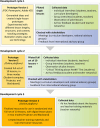Teaching critical thinking about health information and choices in secondary schools: human-centred design of digital resources
- PMID: 39246586
- PMCID: PMC11377934
- DOI: 10.12688/f1000research.132580.3
Teaching critical thinking about health information and choices in secondary schools: human-centred design of digital resources
Abstract
Background: Learning to thinking critically about health information and choices can protect people from unnecessary suffering, harm, and resource waste. Earlier work revealed that children can learn these skills, but printing costs and curricula compatibility remain important barriers to school implementation. We aimed to develop a set of digital learning resources for students to think critically about health that were suitable for use in Kenyan, Rwandan, and Ugandan secondary schools.
Methods: We conducted work in two phases collaborating with teachers, students, schools, and national curriculum development offices using a human-centred design approach. First, we conducted context analyses and an overview of teaching strategies, prioritised content and collected examples. Next, we developed lessons and guidance iteratively, informed by data from user-testing, individual and group interviews, and school pilots.
Results: Final resources include online lesson plans, teachers' guide, and extra resources, with lesson plans in two modes, for use in a classroom equipped with a blackboard/flip-chart and a projector. The resources are accessible offline for use when electricity or Internet is lacking. Teachers preferred the projector mode, as it provided structure and a focal point for class attention. Feedback was largely positive, with teachers and students appreciating the learning and experiencing it as relevant. Four main challenges included time to teach lessons; incorrect comprehension; identifying suitable examples; and technical, logistical, and behavioural challenges with a student-computer mode that we piloted. We resolved challenges by simplifying and combining lessons; increasing opportunities for review and assessment; developing teacher training materials, creating a searchable set of examples; and deactivating the student-computer mode.
Conclusion: Using a human-centred design approach, we created digital resources for teaching secondary school students to think critically about health actions and for training teachers. Be smart about your health resources are open access and can be translated or adapted to other settings.
Keywords: critical health literacy; critical thinking; educational design; health education; human centred design; infodemic; informed decision making; secondary school.
Copyright: © 2024 Rosenbaum S et al.
Conflict of interest statement
No competing interests were disclosed.
Figures









References
MeSH terms
LinkOut - more resources
Full Text Sources

